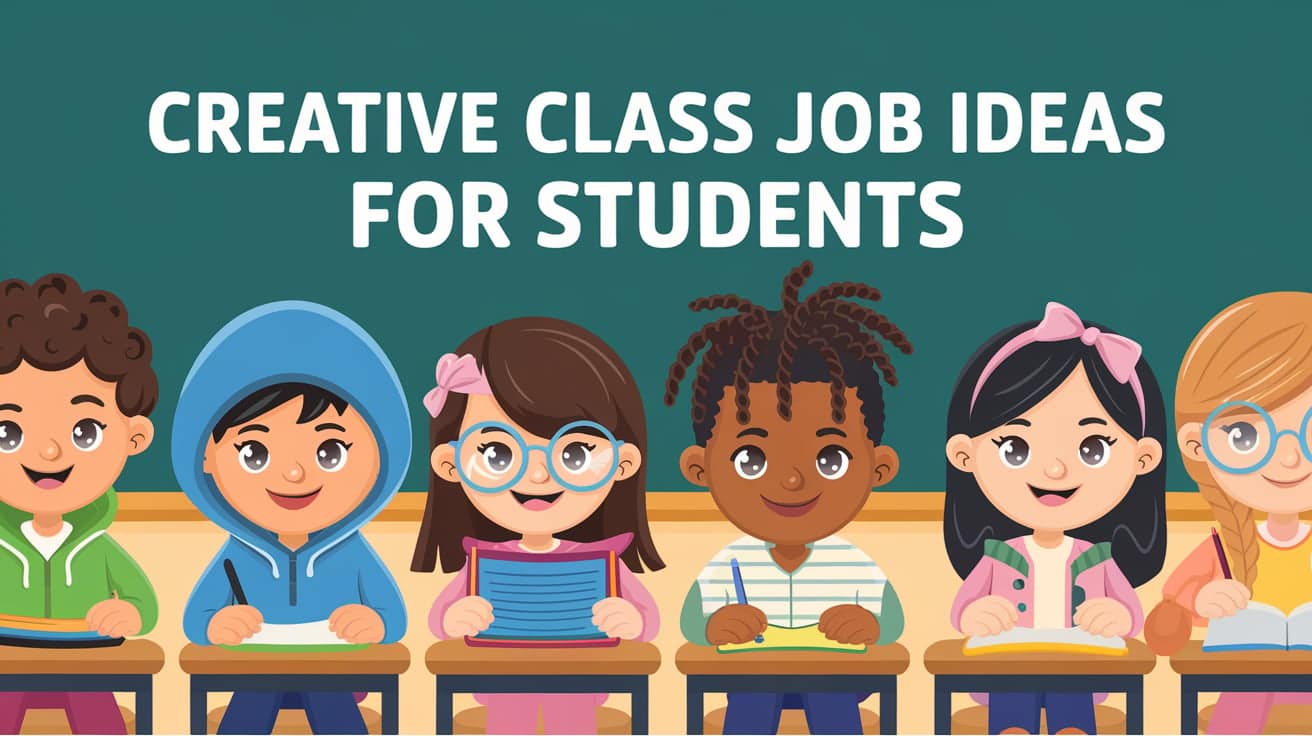Ever walked into a classroom that runs like clockwork? And the teacher isn’t frantically doing everything? That’s classroom jobs in action.
Classroom jobs give students real responsibility while making a teacher’s day much easier. When children take ownership of classroom tasks, they develop leadership skills and learn the value of contributing to their community.
These small roles help students feel important and needed.
For teachers, classroom jobs mean better classroom management with less stress. Tasks get completed without constant reminders, and students learn responsibility along the way.
In this blog, we’ll find the perfect class job ideas for students.
Classroom Jobs: A Fun Way to Engage Students
Classroom jobs make school more fun for kids while helping teachers manage daily tasks. When students have assigned responsibilities, they feel important and develop a sense of belonging in their learning community.
Teachers can create visual job charts showing current assignments, making the system clear and organized for everyone.
Through classroom responsibilities, students develop crucial life skills like reliability, time management, and teamwork. Forgotten tasks become gentle learning opportunities rather than failures. This system works effectively across all grade levels, with job complexity adjusted appropriately for different ages.
Regular rotation of assignments ensures every child experiences various roles and develops diverse abilities. Acknowledging good work with praise strengthens students’ confidence and motivation.
By implementing a classroom job system, teachers create a community where students understand that their contributions matter.
This approach creates a more smoothly functioning classroom while building skills that benefit students far beyond the school year.
Classroom Job Ideas

These unique classroom job ideas will not only help you manage the classroom effectively but also offer opportunities for students to show up and get that sense of responsibility:
- Attendance Taker – This responsible student starts each day by checking who’s present in class. They carefully mark the attendance sheet, counting empty seats and noting late arrivals.
- Librarian – The classroom librarian keeps the book corner organized and inviting. They sort returned books onto correct shelves, repair damaged books with tape, and help classmates find just the right book for their reading level.
- Line Leader – Leading the class through hallways requires good example-setting. The line leader walks at a proper pace, stays quiet, and shows others the correct route to special classes, lunch, or recess.
- Messenger – When important information needs to travel between classrooms or to the office, the messenger steps up. They memorize verbal messages accurately or carefully carry written notes without peeking. This trusted position requires responsibility and good speaking skills when delivering information to adults or other classes.
- Paper Collector – After assignments are completed, this efficient helper collects everyone’s work. They move systematically around the room, gathering papers in the correct order so the teacher can grade them easily. This job teaches organization and helps the teacher save valuable time during busy classroom transitions.
- Whiteboard Eraser – Between lessons, the whiteboard needs cleaning to make room for new information. This helper uses proper erasing techniques to remove all marker residue without damaging the board surface.
- Desk Organizer – Keeping the classroom tidy starts with organized desks. This student reminds classmates to clean inside their desks regularly, removing crumpled papers and organizing supplies.
- Supply Manager – Classroom materials need careful handling and fair distribution. The supply manager counts out scissors, glue sticks, or markers for group work and makes sure everything returns afterward. They alert the teacher when supplies run low and help organize the supply closet for easy access.
- Timekeeper – Activities run smoothly when someone watches the clock. This student uses a timer or classroom clock to monitor how long remains for each activity. They give five-minute warnings before transitions and help everyone develop time management skills through gentle reminders about using minutes wisely.
- Class Secretary – Important announcements and decisions need recording. The class secretary takes careful notes during discussions, writes down homework assignments, and keeps track of upcoming events. Their notebook becomes a valuable reference that both teacher and students can check when questions arise about what was decided.
- Pencil Sharpener – Writing tools need maintenance, and this student ensures everyone has sharp pencils ready for work. They collect dull pencils at designated times, operate the sharpener properly, and return freshly-sharpened pencils to their owners. This service prevents disruptions during work time when pencils break unexpectedly.
- Trash Collector – Classroom cleanliness depends on proper waste disposal. This helper brings the trash can around during cleanup times, holds it steady for classmates, and empties it when full. They might also check for paper scraps on the floor, teaching everyone about keeping shared spaces clean and respecting the environment.
- Classroom Greeter – First impressions matter when visitors arrive. This friendly student welcomes guests at the door with a smile, introduces them to the teacher, and might offer a brief explanation of what the class is learning. Their warm hospitality helps create a positive classroom atmosphere that visitors remember long afterward.
- Snack Distributor – Hungry students need fuel for learning. The snack distributor washes their hands first, then carefully counts out crackers, fruit pieces, or other snacks so everyone receives an equal portion. They learn food safety, counting skills, and fairness while providing this important service during break times.
- Bathroom Monitor – Tracking bathroom breaks prevents disruptions and ensures safety. This monitor manages the sign-out clipboard, reminds classmates about bathroom pass procedures, and notes if someone is gone too long. Teachers appreciate this help in maintaining classroom flow while allowing for necessary personal breaks.
- Weather Reporter – Starting the day with a weather update helps everyone prepare for recess. This student checks the forecast each morning, reports the temperature and conditions to the class, and might suggest appropriate clothing or activities.
- Group Leader – Small group activities need guidance to stay productive. This student helps distribute materials to their group, makes sure everyone participates equally, and keeps discussions on topic.
- Class Photographer – Special moments deserve documentation. This creative student captures photos of science experiments, art projects, guest speakers, and celebrations.
- Homework Checker- Accountability matters when assignments come due. This responsible student checks that everyone placed homework in the correct collection bin and marks it on a tracking sheet.
- Classroom Helper – Flexibility makes this assistant invaluable. They pitch in wherever needed, whether sharpening pencils during a substitute teacher day or helping a new student find materials.
- Attendance Helper – Supporting the main attendance taker, this assistant helps manage the daily count. They might collect absent students’ work folders, prepare makeup work packets, or deliver the attendance record to the office.
- Lunch Monitor – Mealtime runs more smoothly with helpful oversight. This student helps younger classmates open milk cartons or packaging, reminds everyone about cleanup procedures, and ensures lunch counts are accurate.
- Assistant Teacher – Some concepts need peer explanation. This knowledgeable student helps explain directions, demonstrates techniques during art or science activities, and assists classmates who need extra guidance.
- Name Tag Distributor – Special events run more smoothly when everyone is identified. This organized helper prepares name tags for visitors, substitutes, or class activities, making sure names are spelled correctly. Their attention to this detail helps create a welcoming atmosphere where everyone feels recognized.
- Cleanup Crew – Art projects and science experiments often leave messes behind. These thorough helpers wipe tables, sweep floors, and ensure materials return to proper storage locations.
- Music Manager – The right soundtrack enhances the classroom atmosphere. This student selects appropriate music for different activities—quiet classical for reading time or upbeat tunes for cleanup.
- Classroom Navigator – New activities or spaces need clear guidance. This direction-giving helper shows new students around the classroom, explains center rotations, or leads small groups to special activities.
- Sound Monitor – Learning requires appropriate noise levels. This attentive student listens for rising volume during work time, gently reminding groups when conversations get too loud.
How to Assign Classroom Jobs
There are easy ways to give jobs to students. You can use job forms. Students write why they want a job. This helps them practice writing. You can also talk with students. Ask them about jobs they like. This helps them practice speaking.
Make it fun with random picks. Spin a wheel. Pull names from a hat. Students enjoy the surprise. You can match jobs to skills. A neat student can organize books. A student who needs practice with being responsible can care for the class pet.
Change jobs often. This lets everyone try new tasks. Students learn many skills this way.
Tips for Managing Classroom Jobs
Create a system of rotation, training, visual reminders, and appreciation ensures that jobs remain helpful tools rather than forgotten chores while teaching students valuable life skills.
- Create a smooth handoff with a quick training session where the current job holder teaches the next student what to do.
- Display a simple chart with names or pictures showing who does each job so students can easily check their responsibilities.
- Thank students who perform their jobs well with specific praise, small rewards, or recognition, like “Helper of the Week” certificates.
Conclusion
By giving students meaningful responsibilities, teachers not only lighten their own workload but also root essential life skills in their students.
The pros of this system lie in its flexibility—it can be adapted to any grade level, classroom size, or teaching style. When students see that their contributions directly impact their environment, they develop a deeper connection to their class community.
By implementing classroom jobs, teachers create more than just a well-organized classroom. They build a collaborative community where every student has the chance to shine and develop skills that will serve them throughout their educational journey.
Start implementing these jobs today and transform your classroom!




